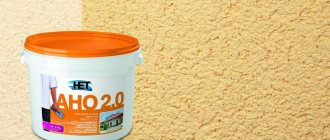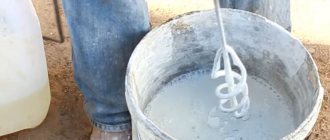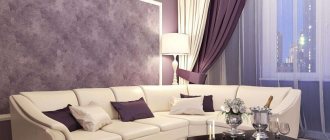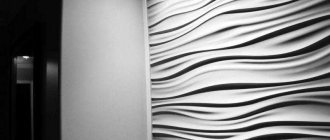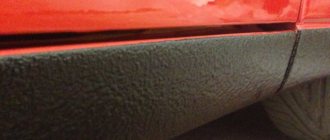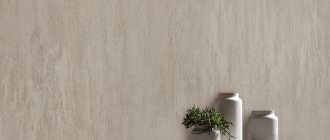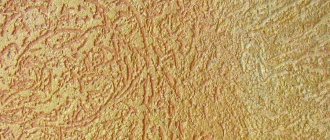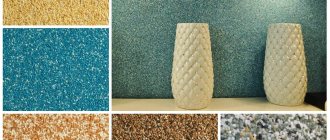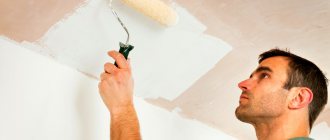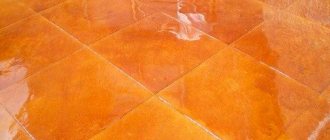Among all kinds of plaster finishes, there are compositions that date back to ancient times and are characterized by unusual properties. Smooth Moroccan plaster for its unique qualities found its way from Morocco, where craftsmen passed on its recipe and application technique from generation to generation for thousands of years. How to create a unique Moroccan decor in the interior? Start by dressing the walls.
Composition of Moroccan plaster
The main feature of this wonder is its complete waterproofness, thanks to which Moroccan decorative plaster can be used instead of tiles not only on walls, but also on the floor, on shelves, tables and other surfaces. In addition to its high resistance to water, it has remarkable strength, which is why sinks are made from it in its homeland. True, for decorative coatings these qualities alone are not enough, because a decorative coating is intended for decoration. The novelty is not in last place here either. In its decorativeness it is not inferior to the famous Venetian. Being smooth, it looks as if it has an interior, with flecks of gold in the depths.
Traditionally in Morocco, the material was used for water tanks and was highly valued for its moisture resistance and antibacterial properties.
All this is possible only thanks to the composition of the Moroccan mixture with natural ingredients:
- Quartz sand,
- hydraulic lime,
- diatomite (sedimentary rock containing the remains of shells and marine organisms - diatoms),
- clay,
- marble flour,
- natural dyes (a lot of pigment, its volume is about 1 part to 9),
Plus - a mandatory coating of a special composition, which, when reacting with lime, forms a salt moisture-proof film:
- linseed oil,
- polishing soap,
- wax.
Is it worth doing it yourself?
You can make the mixture yourself, you just need to know the proportions of the added components. For preparation you need:
- 1 part Portland cement grade M400;
- 0.5 parts lime paste;
- 0.5 parts marble flour;
- 0.5 parts mica;
- 3 parts marble chips.
Components for making Moroccan plaster with your own hands
Depending on the required color, you will need 3-5 parts of ocher, 5-10 parts of red lead or 1-5 parts of manganese peroxide.
Making the solution yourself is beneficial only if you have direct access to the necessary components.
Large manufacturers can contact suppliers directly and purchase everything they need at wholesale prices. An ordinary person does not always succeed in this, so it is better to purchase a ready-made composition.
Advantages and disadvantages
The composition, which has passed the thousand-year test, has a lot of advantages.
Moroccan plaster:
- universal, can be used for both interiors and facade work,
- unique - replaces tiles, has non-standard applications,
- hygienic, environmentally friendly,
- minimalist luxurious,
- flexible, pliable in work,
- the Moroccan wall can have different shapes, the tadelakt will easily follow it,
- durable,
- resistant to open fire, can be used for finishing fireplaces,
- waterproof,
- large selection of colors used,
- easy to maintain, easy to clean,
- has a neutral odor,
- lets the walls breathe,
- not susceptible to biodestruction,
- highly decorative, has a glossy surface.
Minuses:
- difficulty of application technique for beginners,
- quite labor intensive
- high cost,
The non-classical mixture is not sufficiently resistant to scratches and other mechanical damage.
Where is the material used?
In the homeland of plaster - Morocco - it is used to make sinks and also cover containers for storing water, because it is not at all afraid of moisture. However, the use of tadelakt for finishing apartments, houses, cottages and public buildings is considered more traditional. The material is no less suitable for decorating shopping centers, halls for various purposes, cafes, restaurants, and hotels. Fireplaces, stoves and even floors are finished with plaster.
Tadelakt in a Moroccan interior
Tool for the job
The standard set of tools for applying special plaster - tadelakta - has been expanded:
- It will be more convenient to work with several spatulas, ranging from narrow (4 cm) to wide (up to 60 cm); for rounded surfaces, you may need rubber spatulas,
- bristle brushes,
- stainless steel trowel with rounded corners,
- polishing stone (stones must have a certain hardness on the Mohs scale from 7 to 10),
- roller,
- wooden spatula,
- sander,
- rubber roller for painting (do not use a regular roller),
- masking tape,
- containers,
- clean cloth or rags.
How to apply the solution.
The price per square meter of such coverage can be very high. Therefore, you can apply it yourself. Moroccan plaster is applied in two stages - preparation and finishing. The following tools may be required for work: plaster trowel, spatulas (including rubber spatulas for rounded surfaces). The work process can be divided into stages:
- Preparation. The wall must be leveled with an appropriate plaster mixture. A smooth and dry surface is glued (painted with tile adhesive). This will increase the adhesion of the “Moroccan” to the wall.
- The first layer is applied very thinly (approx. 1mm) onto the barely dry layer of glue (tack-free) with a metal trowel or spatula. It is preparatory, priming.
- The second layer is “stuffed” with a natural or artificial sponge. Its size is about 15x15x15 cm. Moroccan textured plaster should have a noticeable volume, so you should not use kitchen foam rubber for washing dishes: it will not give the desired effect, and it will collapse too quickly.
Surface preparation
There is no need to remind you of the importance of preparatory work. Decorative plaster, originally from Morocco, is particularly demanding in terms of the quality of preparation of the base, since the coating itself is small in thickness.
The walls are cleaned, leveled, degreased and disinfected. Metal parts are insulated with special means. For walls in dry rooms, finishing putty is used.
Gypsum putty cannot be used for walls in “wet” rooms.
The walls are primed with a deeply penetrating compound. Apply it crosswise in two layers with a brush to achieve better adhesion. The first layer is dried for 3 hours. The second one is 6-8. For classic tadelakt, casein primer is used.
Visual effect
Of course, we cannot help but touch on the topic of beauty that Moroccan plaster has. Walls covered with such material look, as they say, expensive and rich. A wonderful visual effect is created. It seems that the walls are covered with a pleasant-to-touch precious stone with the addition of silver or gold inclusions.
In order to create a “golden” effect, Moroccan plaster is coated with a special wax composition, which imitates gold. Using this technique in interior design, you should think about whether it can handle such luxury. After all, in the end you will get a real palace style.
Application technology
Tadelakt has long been used in palaces, where it is considered a luxurious decoration; it has its own technology, which not many craftsmen in other countries are fluent in. In Europe, of course, Venetian, sand or silk plaster was more often used. Classical technology is considered complex due to the multi-layer nature and labor-intensive polishing.
Olive oil soap used to coat lime mortar reacts to form calcium stearate, a water-insoluble compound of calcium salts, stearic and other fatty acids. This substance is antibacterial.
Moroccan plaster is sold in the form of a powder, which is combined with water half an hour before use, or as a product ready for application. In the first case, the prepared solution is mixed again half an hour after mixing. In the second case, the mixture is stirred before work. The volume of added color can reach 1/10 of the total volume. Since lime mixtures become very light when dry, it would be correct to do test colors when choosing a color.
When working, you need to outline the surfaces to be treated with masking tape; remove it without waiting for the coating to dry.
Classic Moroccan plaster
- The substrate is lime plaster with coarse grain. It is applied to walls without compaction in a single layer, on the floor - in two layers. The layer thickness is slightly larger than the grain size. If lime plaster is applied to a lime base, the base should be moistened before plastering. After application, this coating takes 14-16 hours to dry.
- The main layer of tadelakt, slightly thicker than a grain, is applied with a trowel, also without compaction (some surface irregularities are possible). They give it the opportunity to set and dry a little.
- 2nd – the texture layer is applied with a thickness of no more than the grain size
- Without waiting for the solution to dry, as soon as it sets on top, they begin polishing its surface with a stone. Polishing is done with small circular movements without pressure. When shine appears and a characteristic “stone-hard” sound is heard, polishing is complete.
- Apply polishing soap with a brush, then, after waiting a little until it begins to be absorbed, begin polishing with a stone. After polishing, allow to dry for 24 hours.
Moroccan plaster is often called not the material itself, but certain application techniques. In this way, they give the interior a Moroccan style
Application by brush
Another technique for applying tadelakt allows you to create a multi-color coating.
- The first layer is applied similarly to the main one from the previous description.
- The second is applied with a brush and spatula. To do this, prepare a “palette” - small containers with a composition painted in different colors. The brush is dipped in the solution of the first color and individual strokes that lag behind each other are applied by trimming to the surface of the wall. After applying each stroke, rub it with a cross-shaped movement of the spatula.
- After applying several strokes of the same color, apply strokes of a mixture of a different color between them with a brush and spatula. You can use a brush to pick up a little solution of different colors, then the strokes will be striped, and the drawing after rubbing with a spatula will be more interesting.
- The surface is polished with stone.
- The soap composition is applied and then polished a second time.
Easy application
- The main layer (approximately 1 mm) is applied evenly, as with putty.
- To apply it, you can use a sea sponge, brush, broom or trowel. The mixture is applied by trimming. Before applying the smear, the instrument is “blotted” using tamponing movements on the bucket lid to remove excess solution. Another possibility is also possible: the most “tasty” strokes are applied at the same distance from each other, and the less “tasty” ones are applied between them.
- After allowing the solution to set and begin to dry, it is compacted with a wooden spatula, and then polished with a stone.
- The compacted polished solution is covered with soap and polished again until shiny.
Sponge application technique
To apply the mixture you will need a tight sponge with rounded edges.
- The solution is applied with a narrow spatula to the surface of the sponge (like a trowel) and, after leveling on the sponge, is transferred in a circular motion to the wall. At the same time, they try to cover the entire substrate. The sponge gives a slight relief. You can apply the material with a trowel, and then use multidirectional circular movements without pressure to give the layer a texture.
- The dried layer of ironstones is used to polish the tops of the relief using the edge of a trowel with slight pressure. The surface of the trowel must be wiped regularly so that hard lumps do not remain on it and damage the finish.
- The wax is tinted. Apply with a trowel, trying to fill the recesses of the plaster coating with wax.
- After 20-30 minutes, the wax is polished with a grinder or a drill with a disk (do this at low speeds so that the wax does not burn). After polishing mechanically, you can polish it manually.
Moroccan with cracks
The coating is very similar to the Venetian. By choosing the color, you can achieve the effect of noble marble. In this case, a primer with quartz sand is not used.
- The first layer is applied sparingly on the strip, crosswise without gaps.
- The second layer covers approximately 95% of the surface (some areas are left uncovered).
- Using a sharp instrument, cracks are scratched into the undried layer. Wider lines are for the main body of the crack; thin cracks are drawn with a sharper object.
- After drying, the surface is treated with sandpaper. No. 180.
- A layer of varnish is applied with a spatula in order to fill cracks and micropores (the absorbency of the surface decreases. Dust that cannot be completely eliminated is saturated with the varnish and becomes part of it. Excess varnish is also removed with a spatula.
- After the varnish has dried, wax with the addition of mother-of-pearl is applied to the surface.
- Final polishing is done mechanically with a wool disc.
Imitation acrylic plaster
Natural lime composition is very expensive. It can be replaced with an acrylic-based mixture. The mixture is tinted before use, not forgetting that the tone fades when it dries. You can add several pigments. To obtain a natural natural color, just a little black color is added.
- The first layer is applied with an acrylic mixture that does not contain marble chips and quartz filler. You need to apply the layer evenly, but you can’t do it perfectly, since the unevenness will be leveled out after applying the second layer.
- The second layer is applied after about an hour with light, short cross movements of the spatula. This creates a low-relief texture with many small differences.
- After an hour, gold varnish is applied with a spatula using arc movements “on the scrape”. If desired, gold varnish can be diluted with silver.
The first layer is applied approximately 1 mm thick, evenly, as when puttying.
Finishing
If the classic Moroccan plaster technique is used, then the final stage is to treat the surface with wax. If finishing is carried out in the bathroom or in other rooms with high humidity, then the procedure is repeated after 3 days. This cladding consolidates the technical and decorative properties of the coating.
The last layer of coating is treated with special wax
In some cases, it is permissible to treat the coating with acrylic-based varnish. You can pre-add pigment to the mixture.
It takes at least 8-12 hours for the plaster layer to dry. The time depends on the manufacturer and composition of the mixture, as well as the proportions of the components taken.
Moroccan plaster in the interior photo
A true classic coating - tadelakt - requires skill and experience in application. This type of coating is expensive and the work takes a long time. But you can paint the walls of your home with beautiful and durable Moroccan plaster with your own hands. This can be done on a budget and with good results.
What to look for when purchasing
To choose the right finishing material, you need to consider the following factors:
- The room in which finishing will be carried out. Plaster is environmentally friendly, but when choosing, take into account the color of the coating.
- Ready solution or dry material. The first type is suitable for beginners who are learning how to decorate an interior. To properly dilute dry powder, exact adherence to the proportions specified by the manufacturer is required.
- Manufacturer. It is better to buy such products at certified points of sale, where you can require the appropriate documents.
- Price.
It is recommended to purchase plaster in specialized stores
Moroccan plaster is a finish that allows you to create a real royal style. However, you need to choose it correctly and use the right tool. To apply the mixture yourself, you need minimal experience working with plaster compositions.
Have you ever done Moroccan plaster yourself? What difficulties may newbies encounter? Share your experience in the comments.
